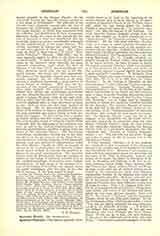

Apostolic Churches. —The epithet Apostolic (apostolikos) occurs as far back as the beginning of the second century; first, as far as known, in the superscription of Ignatius’s Epistle to the Trallians (about 110), where the holy bishop greets the Trallian Church en apostolico charakteri: “in Apostolic character”, viz., after the manner of the Apostles. The word Apostolic becomes frequent enough from the end of this century on, in such expressions as an “Apostolic man”, an “Apostolic writing”, “Apostolic Churches”. All the individual orthodox churches could, in a sense, be called Apostolic Churches, because they were in some more or less mediate connection with the Apostles. Indeed, that is the meaning in which Tertullian sometimes uses the expression Apostolic Churches (De Pnescriptionibus, c. xx; Adversus Marcionem, IV, v). Usually, however, especially among the Western writers, from the second to the fourth century, the term is meant to signify the ancient particular Churches which were founded, or at least governed, by an Apostle, and which, on that account, enjoyed a special dignity and acquired a great apologetic importance. To designate these Churches, Irenaeus has often recourse to a paraphrase (Adv. Haer., III, iv, 1), or he calls them the “oldest Churches”. In the writings of Tertullian we find the expressions “mother-Churches” (ecclesitematrices, originales), frequently “Apostolic Churches” (De Praescriptionibus, c. x) d). At the time of the Christological controversies in the fourth and fifth centuries some of these Apostolic Churches rejected the orthodox faith. Thus it happened that the title “Apostolic Churches” was no longer used in apologetic treatises, to denote the particular Churches founded by the Apostles. For instance, Vincent of Lerins, in the first half of the fifth century, makes no special mention in his “Commonitorium” of Apostolic Churches. But, towards the same epoch, the expression “the Apostolic Church” came into use in the singular, as an appellation for the whole Church, and that frequently in connection with the older diction “Catholic Church“; while the most famous of the particular Apostolic Churches, the Roman Church, took as a convenient designation the title “Apostolic See” (Vincent of Lerins’s Commonitorium, c. ix). This last title was also given, though not quite so often, to the Antiochian and to the Alexandrian Church.
I. Chief Apostolic Churches.—It is not possible, in a summary, to give an account of the missionary labors of the Apostles and of the foundation of Christian Churches by them. We have, if not complete, at least sufficient, information about the preaching and the works of St. Peter in Jerusalem, Antioch, and Rome; of St. James the Elder in Jerusalem; of St. John in Jerusalem and Ephesus; of St. Paul at Antioch, Iconium, Lystra, Derbe, Troas, Ephesus, Philippi, Thessalonica, Berea, Athens, Corinth, and Rome. In these towns—and not all entitled thereto are included in the nomenclature—there were Christian communities founded by the Apostles that could be called Apostolic Churches. However, when the writers of the second and the third century speak of Apostolic Churches, they refer ordinarily to some only of these churches. Thus, e.g., Irenaeus (Adv. Haer., III, iii, 2) mentions the Roman Church, “the greatest, most ancient and known to all, founded and established by two most glorious Apostles, Peter and Paul”, the Church at Ephesus, and the Smyrnan Church, where he was Polycarp’s disciple. Tertullian enumerates others (De Praescriptionibus, c. xxvi): “You who are rightly solicitous for your salvation, travel to the Apostolic churches.. If Achaia is not distant, you have Corinth, If you are near Macedonia, you have Philippi, you have Thessalonica. If you can go to Asia, you have Ephesus. If you are in the neighborhood of Italy, you have Rome.” Then follows a splendid panegyric of the Roman Church, the first among the Apostolic Churches (see also c. xxii).
The Apologetic Argument of Irenoeus and Tertullian.—The oldest Christian literature shows with great evidence that the first controversies among Christians were always decided by texts of the Old Testament, sayings of Our Lord, and the authority of the Apostles. This last ground was very important in the case of new questions on which there existed no explicit teaching of Christ. Therefore, it is easy to understand that the Apostolic Churches could not be lost sight of in such controversies, and it may be of interest to point out the apologetic argument of Irenaeus and Tertullian, which is founded on the preservation of the Apostolic doctrine in the various Apostolic Churches. Irenaus, having exposed, in the first two books of his great work, “Against the Heresies”, the doctrines of the various Gnostic sects, and having shown their intrinsic absurdity, proceeds in the third book to refute them by means of theological arguments, especially Scriptural ones. But before dealing with biblical proofs, he attempts the other method of convincing heretics, namely, that which consists in appealing to the Catholic tradition preserved in the churches through the succession of bishops. The gist of his reasoning is: The churches being too numerous, it may be sufficient to examine into the doctrine of one, viz., of the Roman Church, or, at least, of some of the oldest churches (III, ii, iii). He says: “Even if there is a controversy about a little question, should we not have recourse to the most ancient churches in which the Apostles dwelt, and take from them the safe and trustworthy doctrine?” (III, iv, 1). Tertullian, with his characteristic energy, takes up the same argument in his famous work “On Prescription Against Heretics”. His general process of reasoning runs thus: Christ chose twelve Apostles to whom he communicated His doctrine. The Apostles preached this doctrine to the churches they founded, and thence the same doctrine came to the more recent churches. Neither did the Apostles corrupt Christ’s doctrine, nor have the Apostolic Churches corrupted the preaching of the Apostles. Heresy is always posterior and, therefore, erroneous. “We have to show,” he says (c. xxi), “whether our doctrine. is derived from Apostolic teaching, and whether, therefore, other doctrines haye their origin in a lie. We are in communion with the Apostolic Churches, because we have the same doctrine; that is the testimony of the truth (Communicamus cum Ecclesiis apostolicis, quod nulls doctrina diversa; hoc est testimonium veritatis). In Tertullian‘s writings against Marcion (IV, v) we find an application of this apologetic argument. Having developed the historical argument founded on the preservation, as a matter of fact, of the Apostolic doctrine in the chief Apostolic Churches, we must add that, besides it, such writers as Irenaius and others used often also a dogmatic argument founded on the necessary preservation of Christian truth in the whole Church and in the Roman Church in particular. The two arguments are to be carefully distinguished.
Ancient Statements Concerning Relics of the Apostles in Apostolic Churches.—The tomb of the Apostle, founder of the Church, was religiously venerated in some of the Apostolic Churches, as, e.g., the tombs of Sts. Peter and Paul in Rome, of St. John at Ephesus. A statement of Tertullian‘s has given rise to some curious questions concerning relics of Apostles preserved in the Apostolic Churches. “Travel” he writes in “De Priescriptionibus” (c. xxxvi), “to the Apostolic Churches in which the seats of the Apostles still occupy their places [apud quas ipsce adhuc cathedrce apostolorum Buis locis praesident], in which their authentic Epistles are still read, sounding their voice and representing their face [apud quas ipsae authenticae litterae eorum recitantur, sonantes vocem et repraesentantes faciem uniuscujusque.] “The words “authentic epistles” might denote merely the epistles in the original text—the Greek (cf. Tertull. De Monogomia, c. xi); but here it is not the case, because in Tertullian‘s time the Greek text of the canonical books was still read nearly everywhere, and not in the Apostolic Churches only. We must take the epistole authenticae to mean the autographs of some Epistles of the Apostles. Indeed in later times we hear of recovered autographs of Apostolic writings in the controversies about the Apostolic origin of some Churches or about claims for metropolitan dignity. So the autograph of the Gospel of St. Matthew was said to have been found in Cyprus. (See E. Nestle, Einfiihrung in das griechische Neue Testament, Gottingen, 1899, 29, 30.) If the authenticae epistolce are the Apostolic autographs, the apostolic seats (ipsce adhuc cathedrce apostolorum) mean the seats in which the Apostles preached, and the expression is not metaphorical. Eusebius (Hist. Eccl., VII, 19) relates that in his time the seat of St. James was as yet extant in Jerusalem. On old pictures of Apostles cf. Eusebius, ibid., VII, 18. Whether or not even the oldest of these statements are historically true remains still a mooted question. We regard it as useless to record what may be found on these topics in the vast amount of matter that makes up the apocryphal Acts of the Apostles and other legendary documents.
HONORE COPPIETERS


